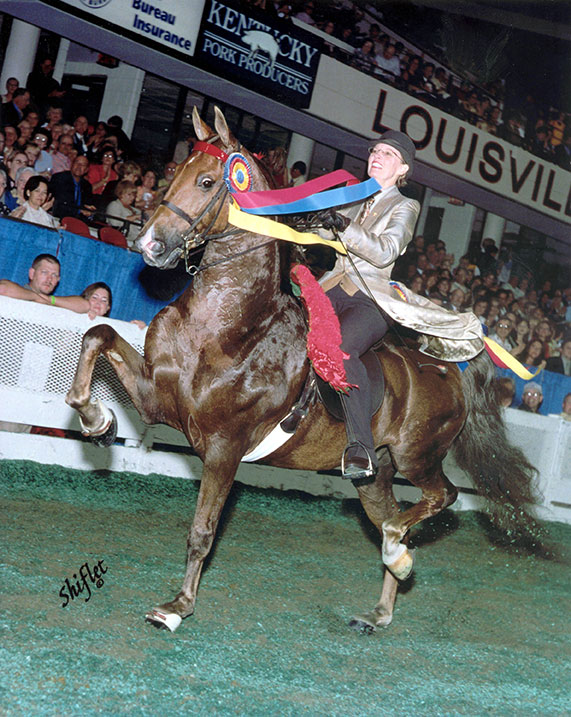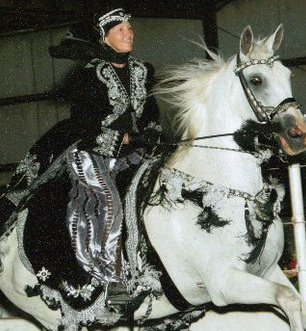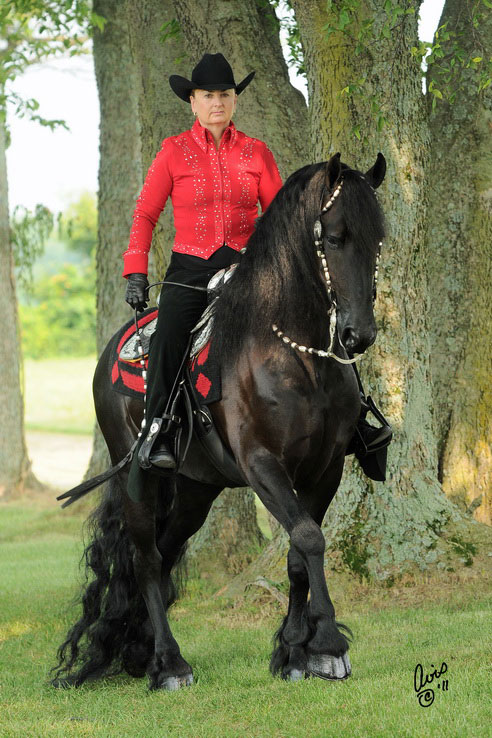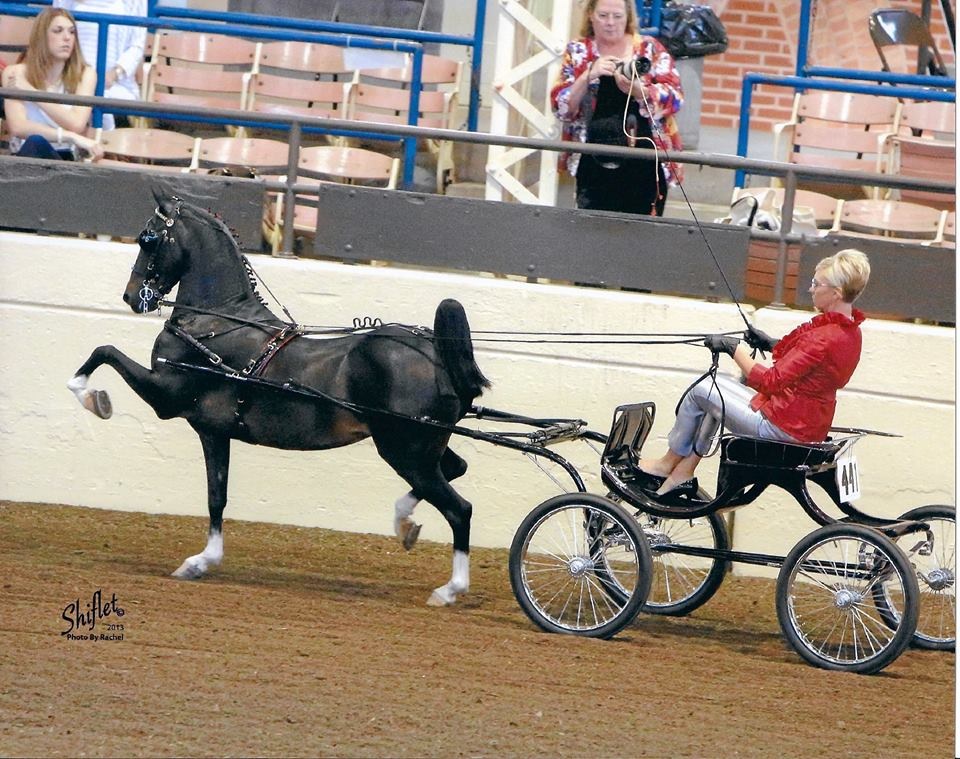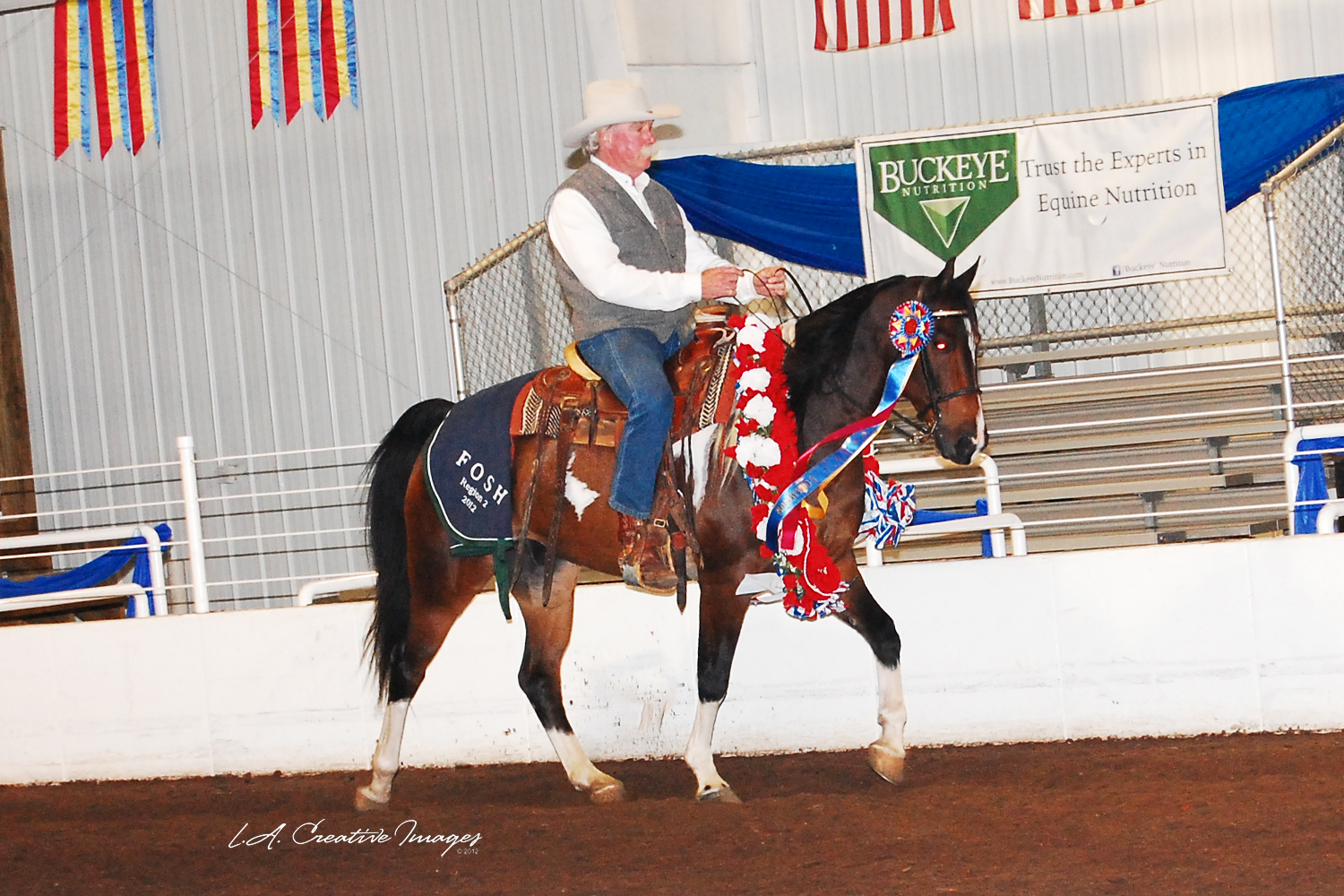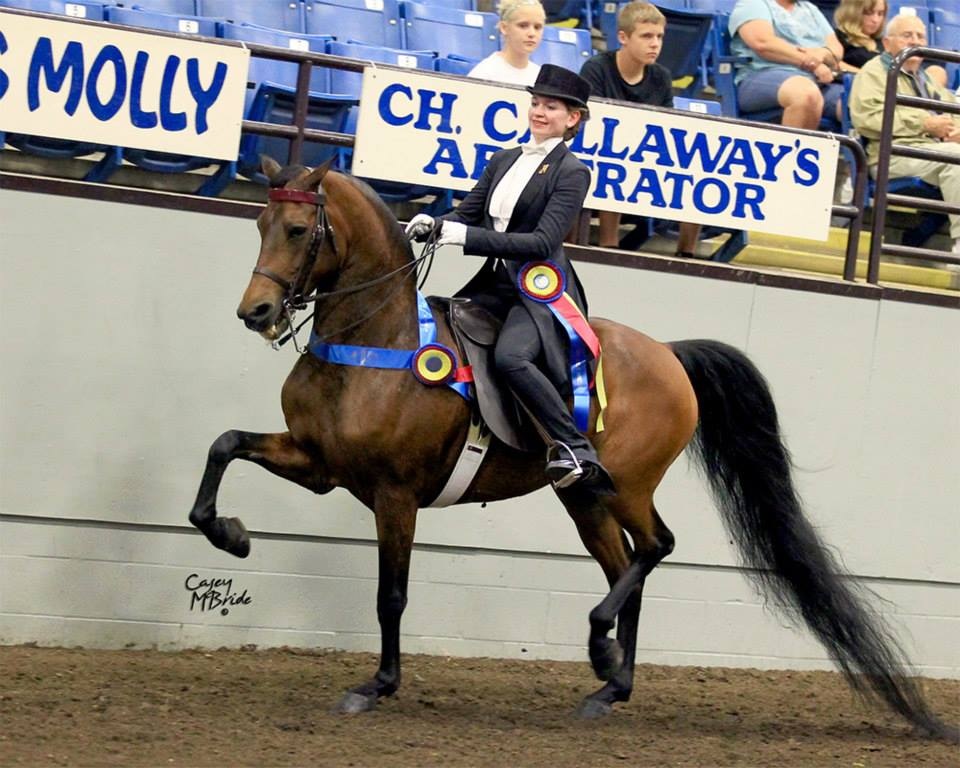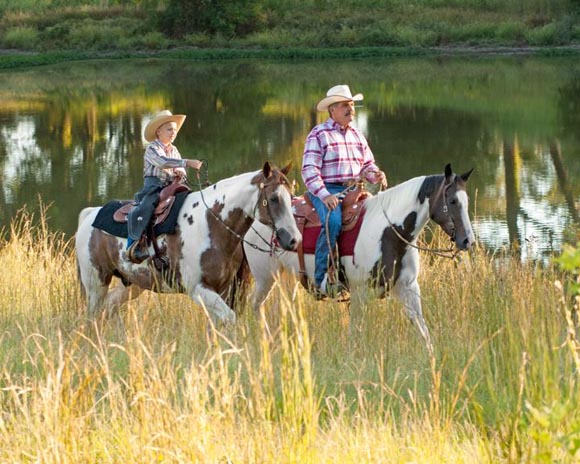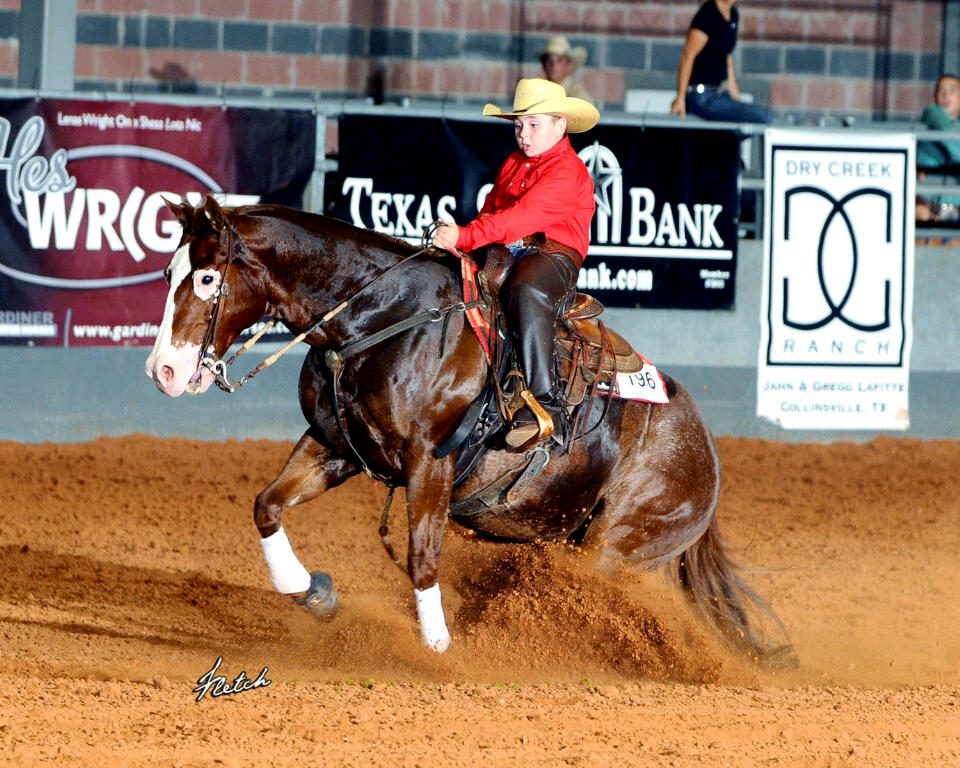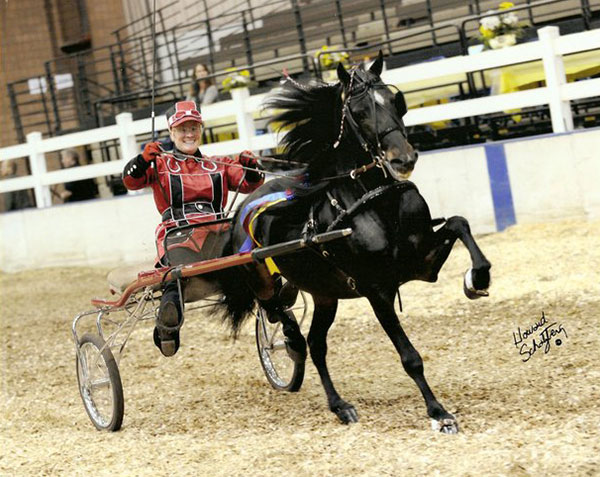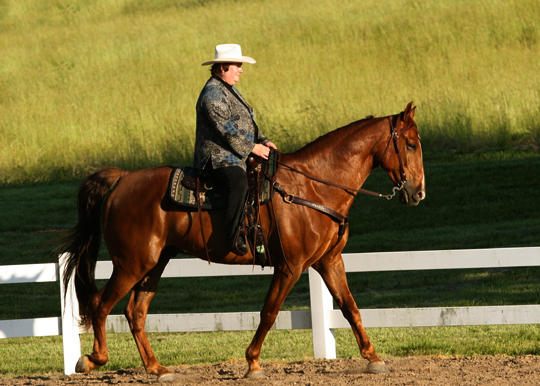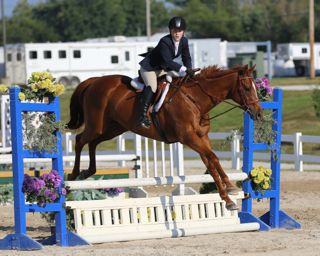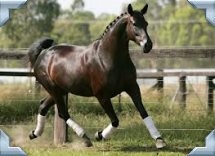Developed in the United States, the American Saddlebred is known for its beauty, love of people, and athleticism. Whether performing in the show ring as a five-gaited, three-gaited or fine harness horse, going cross-country, performing dressage, jumping or riding on the trail, the Saddlebred loves its job. There is a type of Saddlebred horse for every discipline. Many seasoned show horses are wonderful trail horses, giving their owners stylish and pleasant rides. Their beauty and dramatic dispositions have led to the designation of the American Saddlebred as the ‘Peacock of the Show Ring.” Taught to do the slow-gait, and rack, in addition to the natural gaits of walk, trot and canter, the five-gaited horse is showy and charismatic, while being comfortable and thrilling to ride. The trot and the rack of the five-gaited horse are performed with great speed and extreme presence. The sight of a beautiful young girl on a stylish, high motion Saddlebred equitation horse makes an elegant presentation. Missouri has numerous excellent riding programs, many of which also teach show riding.
The Arabian horse, which originated in the Arabian Peninsula, is known as the oldest breed of the modern horse, with archaeological evidence pointing to its existence some 4,500 years ago. Spread around the world through war and trade, the Arabian has added speed, refinement, endurance and strong bone to other breeds. Arabian blood is therefore known as “the Sacred Drop.”
The Arabian is easily recognizable for its fine bone, chiseled, distinctive head shape, and natural, high tail carriage. It is loved for its versatility and high energy. Arabians compete in every discipline, from saddle seat, to native costume; from western pleasure and trail, to combined driving and endurance.
Dramatic, athletic, beautiful, and charismatic are words often used to describe the Friesian. Often reaching 17 hands, the Friesian was first bred in the Netherlands and used throughout the Middle Ages as a war horse. Today’s Friesian registry is carefully guarded to sustain the strong bone, nimble movement and outstanding beauty of the breed. Often used in English Pleasure, as well as Western Pleasure, the great horse is also exhibited in period dress , depicting its use as a strong, dramatic riding and carriage horse.
Friesians are noted for their proud, arched necks, glossy black color and volumes of flowing mane and tail. Long feathers adorn their legs, giving them the dramatic look of ageless beauty.
The Hackney pony, a breed developed in England, along with its larger “cousin,” the Hackney Horse, first served as a classy, sure-footed, high-stepping driving animal throughout the English countryside and on city streets. Especially before the development of the automobile, the stylish Hackney, whether horse or pony, epitomized the golden age of driving, since, hooked to an elegant carriage, it served as the elegant mode of transportation for several generations.
The Hackney was imported to the United States early in its history, and the American Hackney Horse Society, begun in 1891, continues to thrive today.
Hackney ponies are known for their strength of character, their athleticism and their longevity. In the 21st century, they are seen in the show ring in the Roadster, Hackney, Hackney Harness, and Pleasure Driving divisions, as well as in the Roadster Pony and Pleasure Pony Under Saddle divisions. They are equally well-suited to the combined driving discipline, demonstrating the versatility of the breed.
The Missouri Foxtrotter is a well-mannered horse known for its unusual gait, the ‘foxtrot’. The Foxtrotter offers a smooth, ground covering ride and can go for miles without breaking its gait. Developed in the 1800′s in the Missouri Ozarks, the Foxtrotter became a nationally recognized breed in 1948 in Ava, Missouri.
Often described as ‘walking in front while trotting behind’, the foxtrot is actually a four-beat diagonal gait. That is, the front foot lands before the diagonal hind foot, producing a smooth gait with no moment of suspension. The Foxtrotter always has one foot on the ground.
Almost any color, the Foxtrotter may be solid colored, or spotted, and have white stockings or markings.
Missouri Foxtrotters are used extensively for trail rides, as their predictability and smooth gait make for a pleasurable ride. Known for being sure-footed, they are perfect for riders of all ages and levels of riding ability. Foxtrotter owners are dedicated to their Missouri breed, and can attest to their suitability as the perfect family horse.
Morgan horses are easily recognized by their proud carriage and beautiful heads. Morgans have immense endurance and a strong will to work.
Although the first Morgan was named “Figure,” the breed was named for his owner, Justin Morgan. Figure was a small, energetic and beautiful bay stallion, from Springfield, Massachusetts. Figure became known as the horse that could do anything with great style. From pulling heavy loads to trotting in fancy harness, Figure out-performed all competitors. Figure ultimately sired the first six so-called “foundation sires” of the Morgan breed, and is now remembered as the original Morgan horse. Walt Disney brought Figure into preeminence with the general public through the movie, “Justin Morgan Had A Horse” based on the Marguerite Henry book of the same name.
Today’s Morgans, like the Morgans of the late 1700’s, have ability in a variety of disciplines. They show in Saddle Seat, Hunt Seat, Driving and Western, and also compete in Dressage, Eventing, Endurance and performance sports, like reining and cutting. The also are excellent working horses on farms and ranches. Their great disposition makes them perfect family horses and their ‘look at me’ attitude makes them the perfect show horse. Morgan’s are an amazing breed that have played an important role in American history, and continue to be loved by their enthusiastic owners.
The American Paint horse has a history unlike any other breed in the world. Once disregarded by some for its bold markings, that very characteristic makes each Paint Horse a one-of-a-kind favorite with thousands of proud riders and owners. The American Paint Horse’s combination of color and stock horse conformation is not the breed’s only noteworthy attributes – Paints are also valued for their temperaments, versatility and athletic ability.
Each Paint Horse has a particular combination of white and any color: black, bay, brown, roan, buckskin, dun, gray, grullo, perlino, smoky cream, chestnut, cremello, palomino, red dun, sorrel, or champagne. Markings can be any shape or size, and located virtually anywhere on the Paint’s body. Paints’ coat patterns are also varied – Paint Horses are either overo, tobiano, tovero or solid.
Originally used as a stock horse because of its stocky body type, the Paint Horse has gained popularity also as a hunt horse and a flashy pleasure horse. Beautiful, versatile and popular, the Paint Horse has gained popularity in the United States until it now boasts over a million registered paints.
Unlike the Pinto, which is a color registry, the Paint Horse is a breed registry of its own.
An American breed, the Quarter Horse got his name from the quarter mile races he leveled when pitted against larger, lankier horses. Heavily muscled and quick, the smart little horse could out maneuver, out deliver and just plain outwork the bigger horses. Today, the Quarter Horse is loved around the world for its ability as a quiet ranch horse, a dedicated family horse, and a popular show horse.
The American Quarter Horse is well known both as race horse and for its performance in rodeos, horse shows and as a working ranch horse. The compact body of the American Quarter Horse is well suited to the intricate and speedy maneuvers required in reining, cutting, working cow horse, barrel racing, calf roping, and other western riding events, especially those involving live cattle. The American Quarter Horse is also shown in English disciplines such as hunt seat, driving, and many other equestrian activities.
The American Quarter Horse Association is the most popular registry in the world, boasting five million registered Quarter Horses.
Developed in Scotland’s Shetland Islands, Shetland ponies are hardy individuals with limitless energy. First brought to the United States in the early 19th century, the American Shetland Pony Club was formed in 1888, to standardize the popular breed. Shetland ponies appear in the show ring in the Roadster and Harness Pony divisions, as well as enjoying great popularity as a backyard companions to many families.
Widely considered the kindest of all horse breeds, the Tennessee Walking Horse was developed in the southern United States Plantations, providing land owners with a comfortable and safe method of traveling across miles of uneven terrain. A rider could travel many miles and many hours on a Walking Horse and never be saddle sore. Of slightly bigger and stronger bone than many other breeds of “light horses,” the Walking Horse provides their owners with countless hours of pleasure, whether in the show ring or on the trails. Their comfortable, ground-covering gaits and their pleasant dispositions make them the ideal horse for any ride.
Flat-shod Walking Horses are shown under English or Western equipment, and showcase their flat walk, running walk and canter.
The most prominent breed in the Hunter/Jumper division is of course the famous Thoroughbred. Strong boned and sleek, the Thoroughbred is most famous for its prowess on the racetrack. Many Thoroughbreds begin as race horses and often are brought off the track for training as Jumpers, Hunters, Polo ponies and Dressage horses. Today’s’ Thoroughbred is a large horse, often topping 17 hands, with a long stride and athletic body. Known for their agility, speed and spirit, the great horse can fill a variety of disciplines.
The Thoroughbred was developed in 17th and 18th century England by crossing native mares with Oriental stallions, primarily the Arabian, the Barb and Tukomon. The cross of Oriental blood caused the Thoroughbred to be know as a “Hot Blooded” horse, as opposed to the larger, slower moving, larger boned “Cold Blooded” horses.
A number of Warmblood registries exist around the world. The main goal of these registries is to produce and promote the “sport horse”, a horse with strength, longevity and the ability to jump, perform dressage movements, excel at cross country, and remains strong and sound throughout all these endeavors. Thought of as across between the hot blooded breeds, (Arabians, Thoroughbreds, Morgans) and the cold bloods (draft type horses from the working force), the Warm Blood has become a popular part of the American scene. Most warm bloods are performance based, not close registries, with the exception of the Trakehner. Registries based on performance must test horses for movement and conformation before they are registered and especially before they can become breeding stock.
Warmbloods are normally very large, reaching 17 plus hands at their largest. They have larger, more muscular bodies than the lighter breeds, with large feet and big bones.

